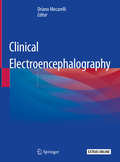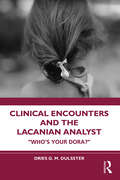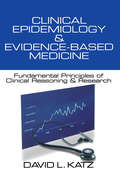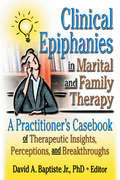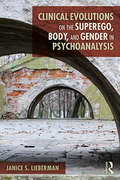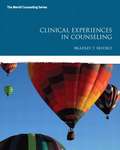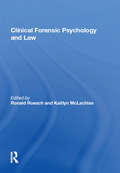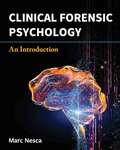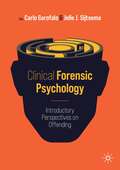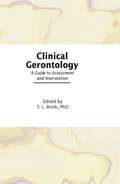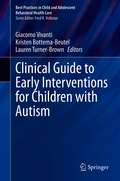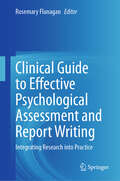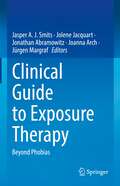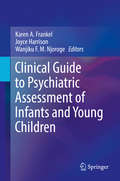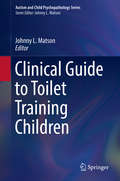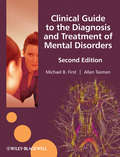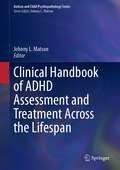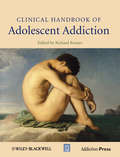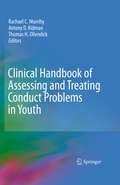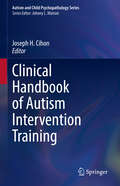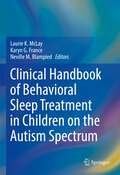- Table View
- List View
Clinical Electroencephalography
by Oriano MecarelliThis book describes the developments and improvements in electroencephalography (EEG). In recent years, digital technology has replaced analog equipments, and it is now possible to easily record and store EEG tracings and to quickly recall previously acquired material for subsequent analysis. In addition, not only static figures, but also electronic supplementary materials can be included in books, enabling EEGs to be viewed in real-time.In clinical practice, EEG still represents the most important functional examination in the study CNS development and its anatomical and physiological integrity throughout life. In the pathological context, EEG provides indispensable diagnostic information for classification of epileptic syndromes, and it is also valuable in all the other CNS diseases (infectious, cerebrovascular, neurodegenerative, etc).Furthermore, monitoring EEG can be widely used in emergency settings, such as emergency departments or intensive care units. In comatose patients, EEG provides information regarding prognosis and evaluation of the sedative effect of anesthetic drugs.Written by a group of leading national and international experts, it offers a substantial, yet practical, EEG compendium, which serves as a reference resource for physicians and neurodiagnostic technologists as well as physicians-in-training, researchers, practicing electroencephalographers and students.
Clinical Encounters and the Lacanian Analyst: "Who's your Dora?"
by Dries DulssterClinical Encounters and the Lacanian Analyst presents interviews with Lacanian analysts, exploring their professional development and the effects that their patients have had on them. Dries Dulsster interviews leading Lacanian psychoanalysts, asking them for insights on the formative effects of working with their analysands. By asking "Who's your Dora?", Dulsster invites the interviewees to reflect on the patients who have changed their practice or influenced the development of key theories. Clinical Encounters and the Lacanian Analyst will be of great interest to practicing and training Lacanian analysts, as well as to Lacanian scholars and academics.
Clinical Epidemiology & Evidence-Based Medicine: Fundamental Principles of Clinical Reasoning & Research
by Dr David L. Katz"The presentation is consistently excellent. One, the writing is lucid and organized in a way that should be very natural for the clinical reader. Two, the text requires no background in mathematics and uses a minimum of symbols. And, three, the methodological concepts and clinical issues are well integrated through a number of carefully prepared and comprehensive examples." Greg Samsa, Associate Director, Duke Center for Clinical Health Policy Research If a patient is older or younger than, sicker or healthier than, taller or shorter than or simply different from the subjects of a study, do the results pertain? Clinical Epidemiology & Evidence-based Medicine is a resource for all health-care workers involved in applying evidence to the care of their patients. Using clinical examples and citing liberally from the peer-reviewed literature, the book shows how statistical principles can improve medical decisions. Plus, as Katz shows how probability, risk and alternatives are fundamental considerations in all clinical decisions, he demonstrates the intuitive basis for using clinical epidemiolgy as a science underlying medical decisions. After reading this text, the practitioner should be better able to access, interpret, and apply evidence to patient care as well as better understand and control the process of medical decision making.
Clinical Epiphanies in Marital and Family Therapy: A Practitioner's Casebook of Therapeutic Insights, Perceptions, and Breakthroughs
by David A. BaptisteHow would you handle these situations? Check your expertise against the approaches presented here!This fascinating collection shows how a practicing therapist handled clients stuck in the therapeutic process. Clinical Epiphanies in Marital and Family Therapy: A Practitioner’s Casebook of Therapeutic Insights, Perceptions, and Breakthroughs presents a cross-section of approaches and orientations as they work in practice. The families and couples discussed here have experienced a wide range of difficulties, and the presenting and commenting therapists run the gamut in age, gender, race, and theoretical orientation.The serendipitous turning points presented here are all true case studies, but Clinical Epiphanies in Marital and Family Therapy offers more than the chance to second-guess a single therapist’s handling of explosive moments. Each case study is also discussed by two other therapists representing divergent points of view. This point-counterpoint structure allows readers to analyze the effectiveness of different therapeutic approaches and to recognize that in practice, heterogeneous orientations may result in similar strategies.Clinical Epiphanies in Marital and Family Therapy demonstrates the factors that contribute to doing successful therapy, including: ensuring that clients feel they are being treated with respect establishing a sound therapeutic relationship making successful treatment bargains moving away from your therapeutic agenda when necessary being persistent in the face of a stubborn refusal to changeClinical Epiphanies in Marital and Family Therapy offers fresh strategies for experienced practitioners, beginning therapists, and educators in the field of mental health.
Clinical Evolutions on the Superego, Body, and Gender in Psychoanalysis
by Janice S. LiebermanPatients in psychoanalytic treatment present with a variety of problems that reflect contemporary cultural issues and values. Clinical Evolutions on the Superego, Body, and Gender in Psychoanalysis explores the effects of such societal changes on psychoanalytic theory and clinical practice, covering topics such as greed, envy and deception, body narcissism, gender roles, and relationships. Janice S. Lieberman includes numerous clinical vignettes and insights into working clinically with changing norms. Lieberman explores how changes in values and norms of behavior in the world beyond the consulting room have influenced what is now heard by analysts within it, using clinical data to demonstrate the psychological underpinnings of the values promulgated by current trends in politics and in society more widely. She explores what she observes to be "a new superego"; where deception abounds and often goes unpunished, where greed and envy have arguably increased and there is an enhanced emphasis on the body and its appearance. Traditional gender roles have been challenged in fortuitous ways, but a certain amount of chaos and confusion has ensued. Relationships are found and maintained using technology, yet many feel lonely and empty. She writes about the clinical dilemmas she has faced and offers suggestions for resolving them in working with today’s patients. Lieberman also sees parallels for these developments in several artists’ lives and in their work. Clinical Evolutions on the Superego, Body, and Gender in Psychoanalysis will be of great interest to psychoanalysts and psychoanalytic psychotherapists.
Clinical Experiences In Counseling
by Bradley T. ErfordClinical Experiences in Counseling gives interns and practicum students the practical, nitty-gritty information and skills they need to successfully complete their clinical experiences, and proudly join the counseling profession with confidence. Packed with case examples, self-assessments, activities, and “voices from the field,” it bridges the gap between theory and practice at the most critical juncture of their training—practicum and internship. Included is ready-to-use information on such critical topics as integrating theory and practice, building relationship, setting goals, record keeping, expectations and getting the most out of the supervision process, assessment and intervention, wellness and developing healthy work and personal habits, applying law and ethics in everyday practice, working with special issues and populations, self assessment, and more.
Clinical Fictions: Psychoanalytic Novelists and Short Story Writers
by Jeffrey BermanClinical Fictions: Psychoanalytic Novelists and Short Story Writers is the first book to explore works of fiction written by prominent psychoanalysts.Broken down into thematic sections, the book traces the literary output of pioneering psychoanalysts such as Julia Kristeva, Bruce Fink, Thomas Odgen, and Gregorio Kohon, among others. Berman looks at works of historical fiction, detective fiction, and the short story, and shows how recurring themes typical of these genres can be understood both psychoanalytically and through a literary lens. The works included investigate experiences of childhood adversity, life in dystopian societies, experiences of psychosis, bodily autonomy, personal loss and, above all, trauma. Unpacking these themes, and their depiction through fiction, Berman gives the reader the tools to apply psychoanalytic literary theory to further works. Interweaving his personal correspondence with authors, including a heartwarming exchange with Cliff Wilkerson, Berman offers unparalleled access to the inner workings of the writers’ minds.This book will be of interest to students and researchers using psychoanalytic literary theory, as well as mental health practitioners who are interested in the intersections between literature and psychoanalysis and discovering new ways of probing the unspoken and unconscious.
Clinical Forensic Psychology and Law (International Library Of Psychology)
by Kaitlyn McLachlanClinical Forensic Psychology and Law is a compilation of recent and classic articles providing comprehensive coverage of the field of clinical forensic psychology and law. Selected articles sample the major areas of the discipline, including criminal and civil forensic assessment, forensic treatment, youth assessment and intervention, and professional and ethical issues in forensic practice. The volume is designed for use by scholars, graduates and undergraduates in psychology and law schools.
Clinical Forensic Psychology: An Introduction
by Marc NescaClinical Forensic Psychology: An Introduction provides students with a succinct and practical overview of the discipline. The text features a distinct focus on the practice of forensic psychology and on the American and Canadian legal parameters that govern that practice. The book covers a diverse range of topics that are organized into four parts. Part I features a brief historical overview of clinical forensic psychology-from its academic origins to its relationship with psychiatry-and clearly defines the field. Part II reviews psychology's relationship with the law, including paradigm conflicts, expertise under the law, and the ultimate issue problem. The foundations of forensic mental health assessment are also reviewed. In Parts III and IV, the text focuses on clinical activities in civil, criminal, and family court contexts. Part III is concerned exclusively with the criminal justice system and examines risk assessment, adjudicative competence, criminal responsibility, and sentencing evaluations, as well as issues associated with the special populations of juvenile, female, and sexual offenders. In Part IV, the chapters focus on civil and family court issues, with chapters covering psychological injury assessment, civil competency evaluations, parenting capacity, and child custody assessments.
Clinical Forensic Psychology: Introductory Perspectives on Offending
by Carlo Garofalo Jelle J. SijtsemaThis book represents a comprehensive collection of theoretical and empirical work at the nexus of clinical and forensic psychology written by world-renowned experts in the field. It is among the first books in the field to focus entirely on clinical psychological science applied to the understanding and treatment of offending. Part I addresses the main theoretical and clinical models used to explain and predict antisocial behavior, spanning biological, cognitive, experimental, individual differences, and interpersonal perspectives. Part II focuses on forms of psychopathology associated with an increased tendency to offend, with the emphasis on describing the clinical constructs most relevant for forensic psychology. Each chapter describes the clinical characteristics of one form of psychopathology, their assessment, their links with antisocial behavior, and treatment considerations. Part III focuses on different types of offense or offender groups as starting points. This perspective has relevance since many criminal justice and forensic mental health systems allocate offenders to interventions based on their index offense (or history of offenses). Finally, Part IV addresses the application of clinical psychology in the service of assessment and treatment in forensic settings. It includes the state of the art on diagnostic and risk assessment, as well as both widely used and recently developed interventions. This book is an excellent resource for students at both Bachelor’s and Master’s level, while also representing a comprehensive handbook for experienced researchers and practitioners.
Clinical Gerontology: A Guide to Assessment and Intervention
by T.L. BrinkHere is a major text in psychogeriatrics for all professionals in the field of aging and mental health. Leading authorities provide valuable insights into assessment and intervention techniques for use with the mentally impaired elderly. Topics include a depression scale for use in later life, family therapy, therapy in later life, and various issues concerning mental health care for the aged.
Clinical Guide to Early Interventions for Children with Autism (Best Practices in Child and Adolescent Behavioral Health Care)
by Giacomo Vivanti Kristen Bottema-Beutel Lauren Turner-BrownThis book examines early interventions for children with autism spectrum disorder (ASD) with the goal to enable primary care physicians as well as other clinicians, therapists, and practitioners to assist parents in making informed decisions based on current research. It provides a map for successfully navigating the maze of early interventions for ASD, focusing on evidence. Chapters review the similarities and differences between current evidence-based treatments, how these treatments work, the factors that facilitate their effectiveness, and the pros and cons of their use for different children and different needs. In addition, chapters discuss the services, laws, policies, and societal issues related to early intervention in ASD. Featured topics include:Criteria to evaluate evidence in ASD interventions.Effective approaches for Social communication difficulties in ASD.Effective approaches for Restricted and repetitive behaviors (RRBs) in ASD.Naturalistic, developmental approaches to early intervention for children with ASDThe TEACCH approach and other visually based approaches for children with ASD.Applied Behavior Analysis (ABA) approaches to early intervention for children with ASD.What works for whom in ASD early intervention Clinical Guide to Early Interventions for Children with Autism is an essential resource for clinicians, primary care providers, and other practitioners as well as researchers, professors, and graduate students in the fields of child, school, and developmental psychology, pediatrics, social work, child and adolescent psychiatry, primary care medicine, and related disciplines.
Clinical Guide to Effective Psychological Assessment and Report Writing: Integrating Research into Practice
by Rosemary FlanaganThe book examines the preparation and presentation of psychological data reports for various stakeholders (e.g., teachers, parents, caregivers). It details strategies for clear and effective prose and visuals that reach beyond the narrative and emphasize data integration. Chapters are organized around specific themes contained in the overall report and its sections (e.g., cognitive, achievement, social/emotional/personality) as well as the process of data reporting, its description, and eventual communication to consumers. The volume addresses the rationale for and considerations important to carrying out this mission, including reporting and explaining data obtained from English language learners (ELLs). It provides examples of sample data sets, detailing how to apply and illustrate these principles and reflect contemporary data interpretation. In addition, the book provides checklists as well as appendices, and tables that should be considered when preparing reports. The book discusses the processes and mechanics of integrating data within and across sections of reports, thereby providing alternatives to strictly boilerplate reports as well as practical recommendations that can be readily implemented to benefit students. Key areas of coverage include: Preparing psychological reports for all stakeholders. Data presentations for lay audiences. Contemporary data reporting not driven by a boilerplate. Illustrations of data integration and customized prose. Generating intervention recommendations for students using descriptive data. Tailoring the writing process to create defensible reports for school, clinical, and neuropsychological referrals. This volume is an essential resource for researchers, professors, graduate students as well as clinicians, therapists, and other professionals in developmental, clinical child and school psychology, educational assessment, testing, and evaluation, social work, public health and all interrelated disciplines.
Clinical Guide to Exposure Therapy: Beyond Phobias
by Jonathan Abramowitz Jürgen Margraf Jasper A. J. Smits Jolene Jacquart Joanna ArchClinical Guide to Exposure Therapy provides evidence-based guidance on how to incorporate and tailor exposure therapy for patients who present with problems beyond fear and its disorders. Exposure therapy is a relatively easy-to-implement intervention with powerful effects. Helping clinicians expand their reach and effectiveness, this clinician’s guide includes chapters on (1) considerations for deviating from standard exposure protocols when patients present with comorbid psychiatric or medical conditions and (2) how to use exposure therapy in the treatment of conditions that do not center on fear or anxiety (e.g., eating disorders, obesity, depression, substance use disorders, chronic pain). Complementing existing resources for clinicians on exposure therapy for the treatment of anxiety disorders, this volume provides guidance on issues related to the planning and implementation of exposure interventions more broadly. This clinical guide an essential resource for the advanced trainee and clinician providing exposure therapy for complex comorbidities and unique populations.
Clinical Guide to Mental Disability Evaluations
by Liza H. Gold Donna L. VanderpoolDisability evaluations are the most common clinical mental health evaluations conducted for nontreatment purposes. They place mental health professionals in the role of communicating information that is typically confidential to administrative and legal systems. Unfortunately, mental health professionals receive little to no training in conducting assessments that focus on disability and disability management, and often do not understand the implications and risks of providing this information, especially without conducting what are often specialized evaluations. Clinical Guide to Mental Health Disability Evaluations is geared for general mental health practitioners, providing them with the basic information needed to competently provide the various types of disability evaluations. It also provides enough information to inform forensic mental health providers in conducting more specialized evaluations.
Clinical Guide to Psychiatric Assessment of Infants and Young Children
by Karen A. Frankel Joyce Harrison Wanjiku F. M. NjorogeThis book provides a clinical guide to the psychiatric assessment of infants and young children, birth through five years, and their families. It offers a comprehensive, data-rich framework for conducting mental health assessments of infants, toddlers, and preschoolers. The book includes a step-by-step guide for evaluation and assessment, reviewing relevant literature and best practices for working with very young children. It begins with an overview of the purpose and principles of psychiatric assessment and offers a protocol for planning and executing a thorough evaluation. Chapters examine critical aspects of the assessment process, including children’s relationships with parents/caregivers, assessment of parents, cultural considerations, and play behaviors. Chapters also provide illustrative case vignettes and information on specialized tools that can be adapted for use in a private office or training clinic.
Clinical Guide to Toilet Training Children (Autism and Child Psychopathology Series)
by Johnny L. MatsonThis book offers a comprehensive overview of the universal issue of toilet training in children and explores issues that need to be considered by clinicians and other professionals. The book begins with a historical overview of the field, including origins and reviews of current practices. It discusses various toileting problems and their side effects, risk factors, normal developmental milestones in toileting, and theories of toileting. Chapters identify behavior problems (e. g. , self-injury, noncompliance) as well as medical conditions (e. g. , diabetes, constipation) that can affect continence, with proven strategies for addressing these challenges in toilet training children, including those with intellectual and developmental disabilities. The book concludes with a discussion of the strengths of current toilet training practices as well as suggestions for areas where continued improvement is required. Topics featured in this book include: #65533; Complications and side effects associated with the lack of toileting skills. #65533; Technology used in toilet training. #65533; Applications of operant-based behavioral principles to toilet training. #65533; Toilet training strategies involving modeling and modifications of the physical environment. #65533; Toilet training children with physical disabilities. The Clinical Guide to Toilet Training Children is a must-have resource for researchers, graduate students, clinicians, and related therapists and professionals in clinical child and school psychology, pediatrics, family studies, developmental psychology, nursing, social work, and behavioral therapy/rehabilitation.
Clinical Guide to the Diagnosis and Treatment of Mental Disorders
by Michael B. First Allan TasmanTwo key challenges face mental health practitioners: making the correct psychiatric diagnosis and choosing the most appropriate treatment option. This book aims to help with both.Clinical Guide to the Diagnosis and Treatment of Mental Disorders - Second Edition combines clinically-relevant information about each of theDSM-IV-TR diagnoses with clear, detailed information on treatment options, giving full clinical management advice. Once again, the editors, both leading psychiatrists, have condensed the chapters on Disorders from Tasman et al's acclaimed two volume textbook of Psychiatry (now in its Third Edition), retaining only the content they deem particularly relevant to the clinician for ease of use.Each disorder is discussed under the headings of Diagnosis (including Assessment Issues, Comorbidity, Course, and Differential Diagnosis, giving diagnostic decision trees where relevant) and Treatment (listing all therapeutic options, giving practical advice for patient management, summarising treatment specifics with tables and treatment flowcharts).The original edition established itself as the first point of reference for any clinician or mental health practitioner needing expert advice on therapeutic options for any psychiatric disorder. This edition features an additional chapter on the psychiatric interview and assessment of mental status to increase its utility.It echoes the progress in psychiatry regarding the establishment of an evidenced-based model of taxonomy, diagnosis, etiology, and treatment. Indeed, from a psychologist's perspective, the equal consideration provided to empirically supported psychosocial treatments versus somatic treatment is a significant development in the field of psychiatry.Jonathan Weinand in PsycCritiques, the American Psychological Association Review of Books
Clinical Handbook for the Management of Mood Disorders
by J. John Mann Patrick J. McGrath Steven P. Roose J. John Mann Patrick J. McgrathThis Clinical Handbook for the Management of Mood Disorders will equip clinicians with the knowledge to refine their diagnostic skills and implement treatment plans for mood disorders based on the most up-to-date evidence on interventions that work. Covering the widest range of treatments and techniques, it provides clear guidance for the management of all types and subtypes of both minor and major depression. Chapters cover the latest and most innovative treatments, including use of ketamine, deep brain stimulation and transcranial magnetic stimulation, effective integration of pharmacological and psychotherapeutic approaches, as well as providing a thought-provoking look at the future research agenda and the potential for reliable biomarkers. This is the most comprehensive review of depression available today. Written and edited by leading experts mostly from Columbia University, this is an essential resource for anyone involved in the care and treatment of patients with mood disorders.
Clinical Handbook of ADHD Assessment and Treatment Across the Lifespan (Autism and Child Psychopathology Series)
by Johnny L. MatsonThe handbook examines the latest research and clinical advancements in assessing and treating ADHD (attention deficit hyperactivity disorder) across the lifespan. It synthesizes the most current research data and trends combined with best-practice interventions to form a comprehensive, state-of-the-art resource. The handbook identifies the most relevant, effective treatments for individuals with ADHD. Key areas of coverage include: Core symptoms of ADHD in minority children. Lifestyles for children with ADHD. Digital interventions for children and adolescents with ADHD. Telemedicine to manage ADHD across the lifespan. Healthcare use and costs for adults with ADHD. The Clinical Handbook of ADHD Assessment and Treatment Across the Lifespan is an essential reference for researchers, professors, and graduate students as well as clinicians and other professionals across such interrelated disciplines as clinical child, school, and developmental psychology, child and adolescent psychiatry, social work, rehabilitation medicine/therapy, pediatrics, and special education.
Clinical Handbook of Adolescent Addiction
by Richard RosnerEdited by members of the American Society for Adolescent Psychiatry, this is a practical guide to the management of an adolescent drug use and addiction. It provides the knowledge and tools for successful prevention and intervention efforts in adolescents. The handbook is organized in a user-friendly format so that readers can easily locate the information that is required.
Clinical Handbook of Anxiety Disorders: From Theory to Practice (Current Clinical Psychiatry)
by Eric Bui Meredith E. Charney Amanda W. BakerThis book is designed to present a state-of the-art approach to the assessment and management of anxiety disorders. This text introduces and reviews the theoretical background underlying anxiety and stress psychopathology, addresses the issues faced by clinicians who assess individuals presenting with anxiety in different contexts, and reviews the management of and varied treatment approaches for individuals with anxiety disorders. Written by experts in the field, the book includes the most common demographics and challenges for physicians treating anxiety, including disorders in children, aging patients, personality disorders, drug and non-drug treatment options, as well as anxiety in comorbid patients. Clinical Handbook of Anxiety Disorders is a valuable resource for psychiatrists, psychologists, students, counselors, psychiatric nurses, social workers, and all medical professionals working with patients struggling with anxiety and stress-related conditions.
Clinical Handbook of Assessing and Treating Conduct Problems in Youth
by Rachael C. Murrihy Thomas H. Ollendick Antony D. KidmanConduct problems, particularly oppositional defiant disorder (ODD) and conduct disorder (CD), are the most common mental health problems affecting children and adolescents. The consequences to individuals, families, and schools may be severe and long-lasting. To ameliorate negative outcomes and ensure the most effective treatment for aggressive and antisocial youth, early diagnosis and evidence-based interventions are essential. Clinical Handbook of Assessing and Treating Conduct Problems in Youth provides readers with both a solid grounding in theory and a comprehensive examination of the evidence-based assessment strategies and therapeutic practices that can be used to treat a highly diverse population with a wide range of conduct problems. It provides professional readers with an array of evidence-based interventions, both universal and targeted, that can be implemented to improve behavioral and social outcomes in children and adolescents. This expertly written resource: Lays the foundation for understanding conduct problems in youth, including epidemiology, etiology, and biological, familial, and contextual risk factors.Details the assessment process, with in-depth attention to tools, strategies, and differential diagnosis.Reviews nine major treatment protocols, including Parent-Child Interaction Therapy (PCIT), multisystemic therapy (MST) for adolescents, school-based group approaches, residential treatment, and pharmacotherapy.Critiques the current generation of prevention programs for at-risk youth.Explores salient issues in working effectively with minority youth.Offers methods for evaluating intervention programs, starting with cost analysis.This volume serves as a one-stop reference for all professionals who seek a solid grounding in theory as well as those who need access to evidence-based assessment and therapies for conduct problems. It is a must-have volume for anyone working with at-risk children, including clinical child, school, and developmental psychologists; forensic psychologists; social workers; school counselors and allied professionals; and medical and psychiatric practitioners.
Clinical Handbook of Autism Intervention Training (Autism and Child Psychopathology Series)
by Joseph H. CihonThis handbook addresses evidence-based training practices for individuals providing applied behavior analysis (ABA) interventions for individuals on the autism spectrum. It provides specific examples of interventions across various contexts and skills and addresses the importance of effective and efficient training as it relates to ABA-based interventions for individuals on the autism spectrum. Additional areas of coverage include, but are not limited to, staffing, clinical judgment, shaping, mealtime interventions, qualities of effective trainers and developing effective training systems. Key areas of coverage include: • Training versus mentorship. • Developing systems and contingencies related to training within an organization. • Ensuring a common vocabulary with trainers and trainees. • Development of clinical judgment. • Cultural considerations within training. The Clinical Handbook of Autism Intervention Training is a must-have resource for clinicians, therapists, and other practitioners and professionals as well as researchers, professors, and graduate students across such interrelated disciplines as clinical child, school, and developmental psychology, child and adolescent psychiatry, clinical social work, public health, rehabilitation medicine/physical and occupational therapy, special education, pediatrics, and neurology.
Clinical Handbook of Behavioral Sleep Treatment in Children on the Autism Spectrum
by Laurie K. McLay Karyn G. France Neville M. BlampiedThis handbook provides an overview of the nature, prevalence, and causes of sleep problems in children with autism spectrum disorder (ASD) and examines the process of using functional behavior assessment (FBA) to treat sleep disorders. It describes several evidence-based treatments and explores how these align with the outcomes of the FBA process, including case illustrations of the assessment and treatment process. The handbook discusses the application of FBA in family contexts, including:The effects on children and families of successful interventions with sleep.How to conduct FBA with clinically complex families.Including the child in the intervention.The evidence of efficacy of other treatment approaches. The handbook addresses sleep problems that are highly prevalent among children and young people with ASD, including sleep onset delay, frequent and prolonged night waking, and unwanted co-sleeping. It explores the profound secondary effects that sleep problems may have on children’s daytime functioning as well as child and parent health and wellbeing. The handbook discusses the causes of sleep problems in individuals with ASD, which may be multifaceted and complex and include physiological, environmental, cognitive etiologies yet almost always have a behavioral or learned component. It examines how FBA can be used to characterize challenging behaviors and identify the antecedents (e.g., environmental context) and consequences that affect such behaviors. The volume details the process of using FBA to assess and treat sleep problems in children with ASD. Clinical Handbook of Behavioural Sleep Treatment in Autism is a must-have resource for clinicians, therapists, and other practitioners as well as researchers and graduate students in clinical child and school psychology, behavioral therapy, social work, public health, developmental psychology, pediatrics, family studies, and child and adolescent psychiatry.
